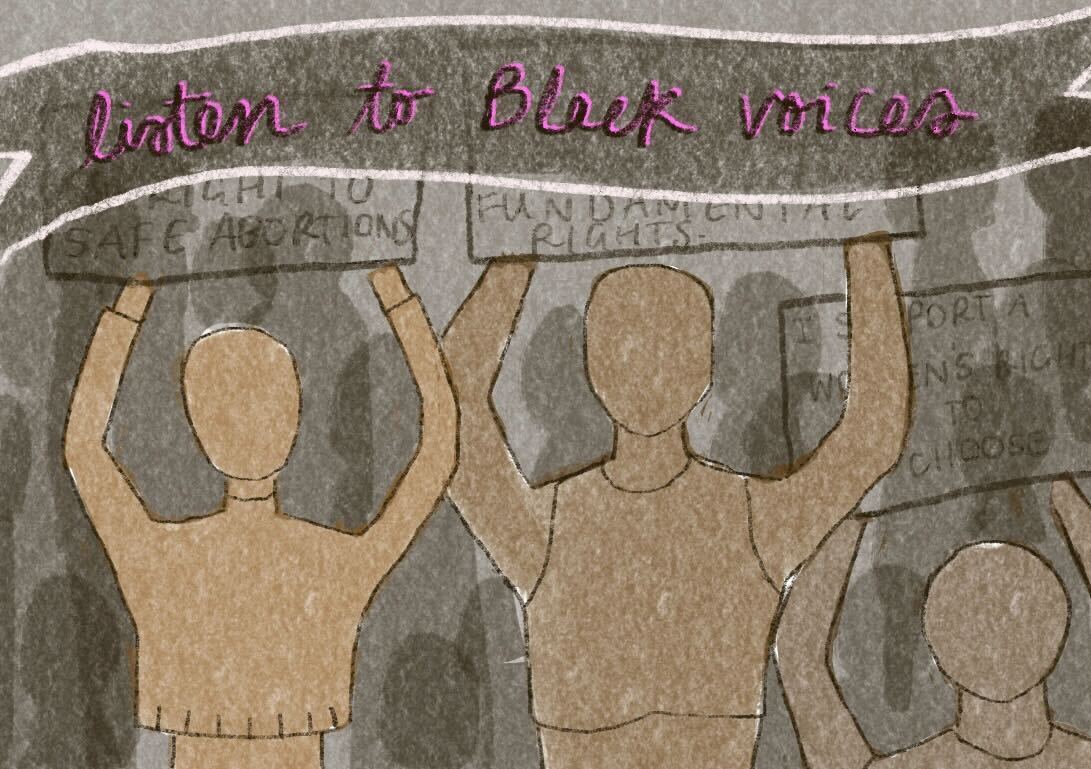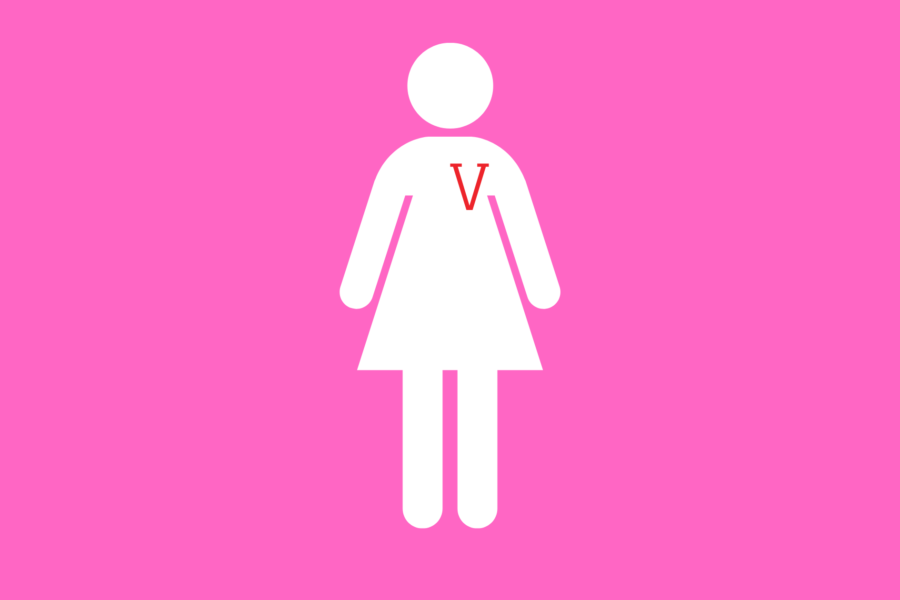By comparing our current political situation to fiction, white feminism ignores that many Black individuals have already been living in a dystopia. But what can be done?

Reproductive Justice: It’s time to stop the Handmaid’s Tale analogy
Note: this article was written by our Sex and Relationships writer, a White Scottish woman, as a response to the recent attacks on reproductive justice, but it does not intend to speak for those who have experienced its impacts. With October being Black History Month we aim to shed light on the disproportionate impacts of these attacks on Black individuals and the long history of racism that precedes that. For this reason we have included a reading list of resources written by Black people on reproductive justice at the bottom of this article. If you would like to add your voice and experiences to this article please email us at meli.clitbait@gmail.com.
CW: abortion, miscarriage, death, racism, eugenics, forced sterilisation
As the US reverberates from the decision to overturn ‘Roe v Wade’, there is a prominent discourse emerging in online discussions comparing our current political situation to the novel The Handmaid’s Tale by Margaret Atwood. At protests, people could be seen wearing long red robes and white hoods resembling those worn in Gilead, a dystopian republic where women (or ‘Handmaids’) are forced to be vessels of reproduction for the ruling class (or ‘Commanders’). However many people, especially people of colour, have taken against this comparison, arguing that the fictional future set out in The Handmaid’s Tale has been the real-life past of Black and Indigenous people for centuries:
At first glance, the current attack on reproductive rights carries a scary resemblance to the rise of Gilead’s regime in the Handmaid’s tale, making it a horrifyingly apt comparison. However, for so many individuals, these circumstances have existed long before the current media uproar. Despite the fact that those who make this comparison most likely mean well, it’s incredibly important to challenge the biases behind this symbolism and ask: “Who does it exclude from the conversation? Why do people identify more with fiction than others’ lived reality?”
So, what exactly is ‘Roe v Wade’? In 1973, the US Supreme Court ruled that the decision whether to continue or end a pregnancy belongs to the individual, not the government1. In June 2022, this ruling was overturned. Within 100 days of the overturning, 66 clinics in the US have stopped providing abortions across the 15 states that have banned the procedure so far – which also happen to be home to the majority of Black folk in the US. For context, this has brought the number of clinics that remain from 73 to 132. Since then, many US cities erupted in protest, with an estimated 10,000 people gathering outside the White House.
To explore the impact of this ruling further, let’s start by having a look back at the history of reproductive justice in the USA. The concept of reproductive justice has been around for centuries, but the term was officially coined in 1994 by a group of Black women in Chicago. They recognized that the women’s rights movement was primarily led by, and represented middle class White women who could not defend the rights of women of colour, other marginalised women and trans individuals. These women published a full-page statement in the Washington Post, with over 800 signatures. Thus, the Reproductive Justice movement was born. Dorothy Roberts, an American sociologist, law professor and social justice advocate, defines reproductive justice as: “the human right not to have a child; the right to have a child; and the right to parent your child in a supportive, humane, and just society”3. This has not been the reality for the Black community for quite a long time.
On the 16th of October 1916 Planned Parenthood was founded by Margaret Sanger in Brownsville, New York. Many revered Sanger for this, and for her role in the creation of the Pill in the 1960s. However, what many Black people have not forgotten is her role in the rise of the Eugenics movement that swept America in the 1920-30s. Eugenics is the abhorrent belief that a population could be perfected through selective breeding. Of course, the Pill provided Eugenicists the perfect opportunity to test their “theory”. Marginalised groups were classed as “unfit”: this included racial minorities; immigrants; the impoverished; and the disabled. Margaret Sanger realised that the success of the Eugenics movement gave her own movement credence, and she aligned her cause with the movement4.
Forced sterilisation was another method which was used for controlling the Black population. From 1937 to 1966, Black women in North Carolina were most likely to be forcibly sterilised. Desegregation coincided with a dramatic increase in this rate. Even as late as between 1997-2010, unwanted sterilisations were performed on around 1,400 women in California prisons; and bear in mind that around 80% of the population of prisons in California are Black and Indigenous People of Colour (BIPOC). 5
The racist history of reproductive justice has left a lasting mark on Black people’s reproductive health. In the USA, there is still a widespread general neglect of BIPOC’s reproductive health6:
- Pregnant people who are Black are three times more likely to die of pregnancy-related complications compared to their White counterparts.
- Babies born to Black parents are two to three times more likely to die than babies born to White parents.
- 31% of Black individuals who can have children and are of reproductive age are enrolled in Medicaid, the nation’s public health insurance program for people with low income.
In addition, due to race-based trauma and fear, the majority of Black women produce around 15% more cortisol – a stress hormone – than White women. Cortisol has significantly harmful effects on the body such as high blood pressure, fatigue, muscle weakness, and slowed healing. These in turn raise the risk of pregnancy complications. In this case, systemic oppression goes as far as to affect the very physiology of Black individuals7. Lawmakers and reproductive rights advocates say that the overturning of Roe v Wade will disproportionately affect Black and Indigenous individuals: a demographic who already face higher risks of health complications and death related to pregnancy and childbirth, and who already have less access to safe abortions. It’s also important to remember that this repeal will not simply prevent abortions from happening, as those who have the means and money will always be able to access them illegally – it will simply decrease access to safe and legal abortions for those who are less privileged.
But what does reproductive justice look like closer to home? The impact of racial injustice on reproductive rights can be obfuscated in more ethnically homogenous societies such as the Republic of Ireland. However, this assumption can be dangerous and misleading. The outlaw of abortion was solidified in law in Ireland when it gained independence from the UK in 1922. In 1983 the Eighth Amendment of the Constitution Act came into effect, which acknowledges the “right to life of the unborn” and puts these on par with the rights of the mother. In 2018, the Eighth Amendment was repealed after a record-breaking turnout voted 66% to 34% in favour of its removal8.
It is crucial to mention that around 40% of maternal deaths in Ireland are migrant and minority ethnic women, despite this demographic making up only 17% of the population. In 2012, Savita Halappanavar, a 31-year-old dentist of Indian descent, was admitted to hospital in Galway. She was 17 weeks pregnant. There, it was determined that she was having a miscarriage. However, because the doctors detected a foetal heartbeat, the “unborn” was protected by the Eighth Amendment. The doctors could not intervene by removing the foetus, thus “ending its life” in the eyes of the law: even to save Savita. Over the course of three days Savita’s pain worsened, and the infection spread. Her and her husband pleaded with the hospital to abort the foetus due to the health risk but, as the foetus still had a heartbeat, this was denied. By the time the heartbeat could no longer be detected, Savita’s uterus had developed a devastating infection which spread to her blood. Following organ failure and four days in intensive care, Savita passed away. 9
This horrifying incident begs the question: if Savita was White, would this have panned out a different way? Would the doctors think twice about their decision due to the inevitable uproar and negative media attention? There are so many factors at play, and for this reason it is so important to acknowledge our own personal privilege, whatever that may be. Although every individual who has periods, or has a uterus, or can bear a child, will be affected by attacks on reproductive rights, individuals who are BIPOC; trans and non-binary; of lower socioeconomic status; or disabled are more likely to be affected by these issues.
So, how do we shift the narrative away from fictional dystopia? Narratives on reproductive justice which are ahistorical exclude from the conversation those for who are impacted the most. When people choose to understand and relate to dystopian fiction, such as The Handmaid’s Tale, instead of Black experiences, it shows there is a fundamental misunderstanding of the political context of these issues. By comparing our current political situation to fiction, white feminism ignores that many Black individuals have already been living in a dystopia. But what can be done? When white feminists find it easier to relate to the oppression of fictional white women than their real Black neighbours, it shows us that the fight for reproductive rights needs to be more intersectional. Intersectional feminism is about amplifying lived experiences; about listening to marginalised voices instead of trying to relate it to your own.
Below, I have included several articles, tweets and reading lists from Black voices on the issue of Reproductive Justice. Take the time to read, to learn, to absorb and to hear. As so beautifully put by Oghenechovwe Donald Ekpeki, a Nigerian author: “The problems of the world are myriad, so will it not then take myriad perspectives and knowledge from all the realities they stem from to solve them?11”
References
- Roe v Wade, the landmark U.S Supreme Court Ruling recognizing the right to abortion. Centre for Reproductive Rights
https://reproductiverights.org/roe-v-wade/
- 66 clinics stopped providing abortions in the 100 days since Roe fell. NPR , 6th Oct 2022
- Reproductive rights have never been secure. Ask Black women. Vox , 13th July 20222
https://www.vox.com/23205101/abortion-rights-reproductive-justice-black-women
- Eugenics and Birth Control. PBS
https://www.pbs.org/wgbh/americanexperience/features/pill-eugenics-and-birth-control/
- Forced sterilisation policies in the US targeted minorities and those with disabilities – and lasted into the 21st century. University of Michigan, 23rd Sept 2020
- Reproductive Oppression against Black Women. University of Illinois Chicago
https://wlrc.uic.edu/reproductive-oppression-against-black-women/
- Facing higher teen pregnancy and maternal mortality rates, Black women will largely bear the brunt of abortion limits. The Texas Tribune, 30th June 2022
https://www.texastribune.org/2022/06/30/texas-abortion-black-women/
- Timeline: The history of abortion in Ireland. The Journal, 30th Dec 2018
https://www.thejournal.ie/abortion-in-ireland-4382738-Dec2018/
- Abortion: The story of suffering and death behind Ireland’s ban and subsequent legalization. The Conversation, 16th May 2022
- White women’s mascot: Dr Savita Halappanavar and the racial politics of abortion rights, Dr Chamindra Weerawardhana, 31st May 2018
- Too dystopian for whom? A continental Nigerian Writer’s Perspective. Oghenechovwe Donald Ekpeki writing for Uncanny: A Magazine of Science Fiction and Fantasy, 6th Sept 2022
Further Reading
- ACLU – A Racist History of Abortion and Midwifery Bans: https://www.aclu.org/news/racial-justice/the-racist-history-of-abortion-and-midwifery-bans
- Brilliant comprehensive reading list curated by Black Women Radicals: https://www.blackwomenradicals.com/blog-feed/black-feminism-and-reproductive-justice-a-reading-list
- A few good tweets:
Graphic by the lovely Lucia Villegas.






Leave a Comment